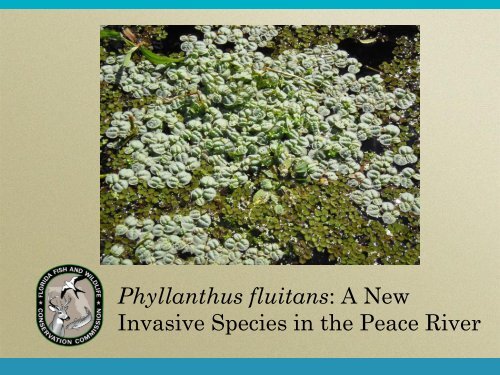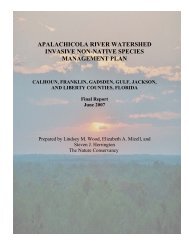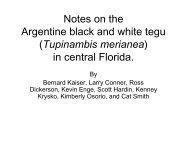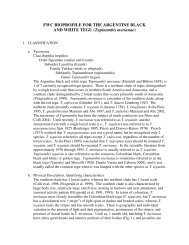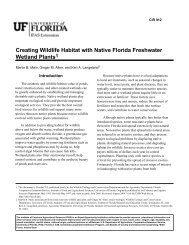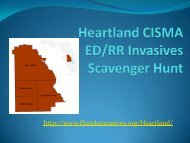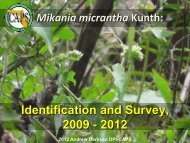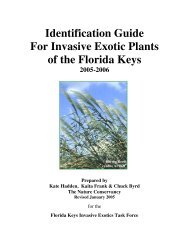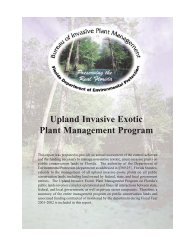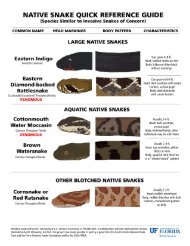Phyllanthus fluitans - Florida Invasive Species Partnership
Phyllanthus fluitans - Florida Invasive Species Partnership
Phyllanthus fluitans - Florida Invasive Species Partnership
Create successful ePaper yourself
Turn your PDF publications into a flip-book with our unique Google optimized e-Paper software.
<strong>Phyllanthus</strong> <strong>fluitans</strong>: A New<br />
<strong>Invasive</strong> <strong>Species</strong> in the Peace River
A Brief History<br />
• Scientific Name: <strong>Phyllanthus</strong> <strong>fluitans</strong><br />
• Common Name: Red root floater<br />
• Native to swamps and rivers in Central and South America<br />
from Mexico to Peru, Paraguay, Bolivia, and Brazil<br />
• Genus <strong>Phyllanthus</strong> contains 650-1,200 species<br />
worldwide, but only two are aquatic:<br />
• P. <strong>fluitans</strong> (floating)<br />
• P. leonardianus (submersed) from Zaire.
Description<br />
• It is a floating aquatic.<br />
• The foliage leaves are arranged in two vertical rows, as leaves on<br />
opposite sides of a stem, light blue-green in color, 1 to 2 cm long, and<br />
they typically lie on surface of the water.<br />
• Each foliage leaf has two large pockets, these pockets being located to<br />
the left and right of the leaf median, respectively.<br />
• Flowers are minute (ca. 2 to 4 mm wide) and whitish.<br />
Credit Kelle Sullivan FWC<br />
Credit Kelle Sullivan FWC<br />
Credit Kelle Sullivan FWC<br />
13 mm
Information from Aquarists<br />
• Growth rate: very slow (very fast?)<br />
• Difficulty to grow: very hard (Easy? Medium?)<br />
• Red leaves develop at high light intensities<br />
Credit: freshwateraquariumplants.com<br />
Credit: www.aquaticplantcentral.com<br />
Credit: www.hessler-markus.de/thumbnails/<strong>Phyllanthus</strong>_<strong>fluitans</strong>3.html
Chronology of <strong>Florida</strong> Occurrence<br />
• Found 8/27/10 in a canal attached to the Peace River by<br />
Dr. George Wilder from the Naples Botanical Garden who<br />
reported it to FWC<br />
• On 9/7/10, FWC and SWFWMD staff visited the site to<br />
confirm and documented 12 additional sightings; voucher<br />
specimens taken to the USF Herbarium in Tampa<br />
• On 9/10/10, found plants 2 river miles upstream of 9/7<br />
sightings<br />
• From 10/4-10/6/10 SWFWMD staff treated all P. <strong>fluitans</strong><br />
plants in original sighting area with diquat
Chronology of <strong>Florida</strong> Occurrence (cont.)<br />
• From 10/19-10/29/10 intense surveying moved the<br />
furthest northern sighting 26 river miles upstream from the<br />
most southern location<br />
• From 11/15-11/18/10 SWFWMD staff treated all P.<br />
<strong>fluitans</strong> plants found in entire 26 mile stretch of the river<br />
• On 4/6/2011, SWFWMD staff and I surveyed entire<br />
infested area of the river and only found two very small<br />
populations in stagnant water areas just off the main river<br />
• End of 4/2011, SWFWMD staff treated the two very small<br />
populations found earlier in the month
Peace River<br />
Watershed<br />
Credit: SWFWMD
Surveying<br />
Conducted by:<br />
• Boat<br />
• Walking<br />
Credit: Michael Sowinski FWC<br />
Credit: Charles Cook DEP BMMR<br />
Credit: Charles Cook DEP BMMR<br />
P. <strong>fluitans</strong> with water lettuce<br />
Credit: Charles Cook DEP BMMR<br />
Credit: Charles Cook DEP BMMR<br />
Credit: Michael Sowinski FWC
Control Measures<br />
In October and November of 2010, SWFWMD staff<br />
sprayed the aquatic herbicide Knockout (active<br />
ingredient diquat dibromide) to kill the plants<br />
Before Treatment<br />
After Treatment<br />
All Photos Credit: Michael Sowinski FWC
Mis-identification<br />
May be confused with:<br />
• Salvinia minima<br />
• Immature water lettuce<br />
(Pistia stratiotes)<br />
Red root floater<br />
Water Lettuce<br />
Duckweed<br />
Credit: www.empire-fotografie.de/Aqua/<br />
Red root floater<br />
Salvinia minima<br />
Credit: Michael Sowinski FWC<br />
Credit: Michael Sowinski FWC
Reproduction<br />
Plants reproduce by:<br />
• Seeds<br />
• Runners/stem fragments<br />
Seeds<br />
Credit Kelle Sullivan FWC<br />
Credit Kelle Sullivan FWC
Growing Requirements<br />
• pH 5.0 to 8.0 (slightly acidic)<br />
• Water temperature 70-86 °F or 21-30 °C<br />
• Soft to medium hard water<br />
• Bright lighting (does poorly in shade)<br />
• Needs iron and micronutrients to thrive<br />
• According to FDEP’s Lists Of Impaired Waters for<br />
Cycle 2 Group 3 Basins verified on 1/15/10 the<br />
Lower Peace River is impaired for iron
How did it get here?<br />
Nursery/Aquarium industry by purchasing and trades<br />
• $3 for “credit card size amount”<br />
• $5.95 for 10 plants; $6.40 for 30; $8 for 41-50<br />
• $10 for two “good size handfuls”<br />
• $24 plus shipping for 5 high quality plants
Is it a problem?<br />
“ When it enjoys good conditions with sufficient<br />
light and nutrients, it has a high growth rate. In fact,<br />
it often requires periodic removal from aquariums<br />
because it blocks light and stops light from<br />
reaching the plants and fish below it.”<br />
Red Aquatic Plants | eHow.com http://www.ehow.com/list_7336245_red-aquatic-plants.html#ixzz1C3R6rHY6
Getting the Word Out!<br />
• Co-authored with Dr. Wilder: <strong>Phyllanthus</strong> <strong>fluitans</strong> Benth.<br />
(Euphorbiaceae) A Newly Reported <strong>Invasive</strong> <strong>Species</strong> in <strong>Florida</strong><br />
found in the Fall 2010, Volume 13, Number 4 of Wildland<br />
Weeds<br />
• FWC Weed Alert was made and distributed<br />
• Visited nurseries, canoe rentals businesses, and parks from<br />
Arcadia north to talk with property managers and distribute<br />
Weed Alerts<br />
• Currently working on an article for Aquatics
Weed Alert<br />
Red Root Floater<br />
(<strong>Phyllanthus</strong> <strong>fluitans</strong>)<br />
In September 2010, this floating plant native to Central and<br />
South America was found in the southern portion of the<br />
Peace River. This was the first time the species had been<br />
found in the United States. It has the possibility of being a<br />
nuisance plant in ponds, lakes and slack water areas of rivers.<br />
13mm<br />
Identification:<br />
• The leaves are arranged in two vertical rows, as leaves on opposite sides of a stem,<br />
light blue-green in color, 1 to 2 cm long, and typically lie on surface of the water.<br />
• Each leaf has two large pockets, these pockets being located to the left and right of<br />
the leaf median, respectively.<br />
• Flowers are minute (2 to 4 mm wide) and whitish.<br />
If found upstream of DeSoto Park in Arcadia,<br />
please contact:<br />
Michael Sowinski – <strong>Florida</strong> Fish & Wildlife Conservation Commission<br />
<strong>Invasive</strong> Plant Management Section<br />
2001 Homeland-Garfield Road, Bartow, FL 33830<br />
michael.sowinski@myfwc.com<br />
Office: 863-534-7074 x230, Fax: 863-534-7181<br />
Red Root Floater taking over canal<br />
All photographs taken by FWC staff
Acknowledgements<br />
• Fl. Fish & Wildlife Conservation Commission - Danielle Schobl, Kelle Sullivan<br />
• South <strong>Florida</strong> Water Management District - Brian Nelson and Ronnie Crosby<br />
• Fl. Department of Environmental Protection - Charles Cook, Michelle Sims<br />
• University of South <strong>Florida</strong> Herbarium - Dr. Richard Wunderlin<br />
• Peace River Manasota Regional Water Supply Authority<br />
• Canoe Outpost: Peace River - Trent Anthney<br />
• Peace River Campground<br />
• Naples Botanical Garden - Dr. George Wilder<br />
• Wildland Weeds editor Karen Brown<br />
Credit: Dr. George Wilder
Michael Sowinski – <strong>Florida</strong> Fish & Wildlife Conservation Commission<br />
2001 Homeland-Garfield Road, Bartow, FL 33830<br />
michael.sowinski@myfwc.com<br />
Office: 863-534-7074 x230, Fax: 863-534-7181


